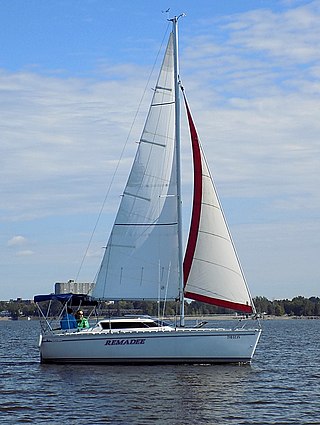Related Research Articles

The Tonic 23 is a French trailerable sailboat, that was designed by Philippe Harlé as a coastal cruiser and first built in 1985.
The Captiva 240 is an American trailerable sailboat that was first built in 1984. The boat is a development of the O.H. Rodgers-designed Rodgers 24 racer, modified for use as a racer-cruiser by Walter Scott by giving it a new keel and sailing rig.
The Coronado 23, also called the Sailcrafter 23, is an American trailerable sailboat that was designed by William Crealock as cruiser-racer and first built in 1969.
The Coronado 25 is an American trailerable sailboat that was designed by Ed Edgar and Frank W. Butler as a cruiser and first built in 1966.
The Dehler 25 is a German trailerable sailboat that was designed by E. G. van de Stadt as a cruiser and first built in 1984.
The Elite 25, also called the Feeling 720 NV, is a French trailerable sailboat that was designed by Michel Joubert of Joubert-Nivelt as a cruiser and first built in 1982.
The Ericson 23-2 is an American trailerable sailboat that was designed by Bruce King as a cruiser and first built in 1975.
The Irwin 25 is an American trailerable sailboat that was designed by Ted Irwin as a cruiser and first built in 1969.
The Eolia 25 is a French trailerable sailboat that was designed by Philippe Briand as a coastal cruiser and first built in 1983.
The Montgomery 17 is an American trailerable sailboat that was designed by Lyle Hess as a pocket cruiser and daysailer and first built in 1973.
The S2 6.8 is an American trailerable sailboat that was designed by Don Wennersten and Arthur Edmunds as a racer-cruiser and first built in 1976. The designation indicates the approximate length overall in meters.
The S2 7.0 is an American trailerable sailboat that was designed by Arthur Edmunds as a cruiser and first built in 1975. The designation indicates the approximate length overall in meters.
The San Juan 23 is an American trailerable sailboat that was designed by Canadian Bruce Kirby and Don Clark as a cruiser and first built in 1975.
The Santana 25 is an American trailerable sailboat that was designed by W. Shad Turner as an International Offshore Rule Quarter Ton class racer and first built in 1973. The boat was Turner's first design.
The Seafarer 22 is an American trailerable sailboat that was designed by McCurdy & Rhodes as a cruiser and first built in 1976.
The Seafarer 23 is an American trailerable sailboat that was designed by McCurdy & Rhodes as a cruiser and first built in 1976.
The Seafarer 23 Kestrel is a Dutch trailerable sailboat that was designed by Sparkman & Stephens in daysailer and cruiser models, first built in 1963.
The Seafarer 29 is an American sailboat that was designed by McCurdy & Rhodes as an International Offshore Rule Half Ton class racer-cruiser and first built in 1972.
The Seafarer 34 is an American sailboat that was designed by McCurdy & Rhodes as a cruiser and first built in 1972.
The Spirit 23, also called the North American 23, is an American trailerable sailboat that was designed by Robert Finch as a cruiser and first built in 1978.
References
- 1 2 3 4 5 6 7 8 McArthur, Bruce (2021). "Seafarer 24 sailboat". sailboatdata.com. Archived from the original on 26 December 2021. Retrieved 27 December 2021.
- ↑ McArthur, Bruce (2021). "McCurdy & Rhodes". sailboatdata.com. Archived from the original on 18 November 2021. Retrieved 27 December 2021.
- 1 2 3 4 5 6 7 8 9 10 11 Henkel, Steve: The Sailor's Book of Small Cruising Sailboats, page 253-254. International Marine/McGraw-Hill, 2010. ISBN 978-0-07-163652-0
- ↑ McArthur, Bruce (2021). "Seafarer Yachts 1965 - 1985". sailboatdata.com. Archived from the original on 18 November 2021. Retrieved 27 December 2021.